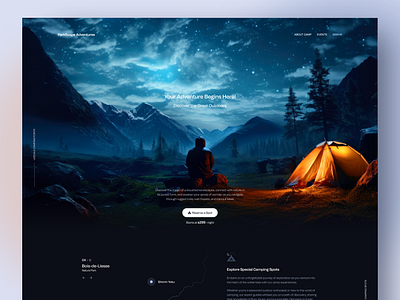Increase Your Organization With Receptive and User-Friendly Website Design
In a period where electronic interactions determine customer actions, the relevance of responsive and straightforward website design can not be overstated. A well-structured website not just suits numerous devices however likewise enhances the overall customer experience, fostering better interaction. Crucial element such as instinctive navigation and engaging visuals play a crucial duty in maintaining site visitors and driving conversions. As businesses progressively compete for online visibility, comprehending the subtleties of effective website design can be a video game changer. What approaches can you apply to ensure your site stands apart in this competitive landscape?
Significance of Responsive Design
In today's electronic landscape, a significant bulk of web traffic originates from mobile phones, highlighting the essential importance of responsive design. As users increasingly accessibility sites through smart devices and tablets, businesses must ensure that their online presence is optimized for various display sizes and resolutions. las vegas web design. Receptive layout not just improves individual experience but also plays an essential function in seo (SEO), as internet search engine focus on mobile-friendly sites

In enhancement to enhancing individual complete satisfaction, responsive style can provide an affordable advantage. In a marketplace where electronic communications are vital, services that prioritize receptive website design setting themselves as forward-thinking, boosting their brand credibility and ultimately driving conversions.

Crucial Element of User-Friendly Design
Simpleness is critical; a tidy, uncluttered layout allows users to browse effortlessly. Instinctive navigation is one more important element, enabling customers to discover information quickly without complication.
In addition, clear typography plays a significant role in customer experience. Choosing legible fonts and proper sizes makes sure that customers can quickly take in content without stressing their eyes. Effective use color and comparison not only enhances appearances but additionally boosts readability and access for individuals with visual problems.
In addition, including interactive aspects such as buttons and web links that are plainly specified and properly spaced motivates individual interaction. Comments devices, like hover results or verification messages, better boost the interaction by giving individuals with confidence that their actions have actually been recognized.
Finally, enhancing tons times can substantially influence user contentment. A fast-loading site lowers bounce rates and maintains users involved, ultimately promoting an extra desirable understanding of the brand name. By concentrating on these components, organizations can develop an user-friendly design that drives success.
Benefits of Mobile Optimization
Mobile optimization is essential for contemporary internet sites, as users increasingly depend on their smart devices and tablets for browsing. With mobile phones accounting for a significant part of net web traffic, companies have to make certain that their websites are fully enhanced for these systems. Among the key benefits of mobile optimization is improved ease of access. Individuals can quickly navigate a mobile-optimized website, which boosts their total experience and increases the possibility of involvement.
In addition, mobile optimization can bring about greater search engine rankings. Online search engine like Google prioritize mobile-friendly sites in their formulas, suggesting that businesses with enhanced websites are most likely to show up in search results page. This exposure can drive extra organic website traffic and prospective clients to the business.
Furthermore, mobile optimization minimizes bounce rates. When customers experience a website that is tough to navigate or slow down to load on their mobile gadgets, they are most likely to leave and seek choices. By supplying a smooth experience, organizations can preserve individuals and transform check outs into sales.
Enhancing User Experience
A well-optimized web site not only accommodates mobile users yet additionally substantially boosts general customer experience. By including receptive layout principles, organizations can make sure that their sites are easily accessible throughout various gadgets and display sizes, creating a seamless surfing experience. This flexibility fosters individual interaction, as site visitors are less likely to come across frustrating navigating issues or altered material.
Moreover, an easy to use interface streamlines interactions, permitting customers to locate information or total deals with convenience. Aspects such as instinctive food selections, clear calls-to-action, and visually appealing layouts add to a positive experience, urging customers to invest even more time on the website. Rapid packing times are one more essential facet, as sluggish sites can cause high bounce prices and disgruntled consumers.
On top of that, boosting customer experience entails taking into consideration the requirements of diverse target markets. Implementing features such as alt text for photos and making certain high contrast in between message and home history can make internet sites a lot more easily accessible to individuals with specials needs. Inevitably, prioritizing user experience not only satisfies existing consumers however additionally draws in brand-new ones, developing a strong foundation for business development in a progressively electronic landscape.
Determining Success and ROI
Determining success and return on financial investment (ROI) in responsive website design is necessary for comprehending its effect on business performance (las vegas web design). To effectively gauge the success of a responsive internet design initiative, services should develop key performance indications (KPIs) that line up with their goals. Typical KPIs include conversion rates, bounce rates, user interaction metrics, and average More Bonuses session durations
Tracking these metrics via analytics devices allows organizations to assess just how well the responsive style satisfies user demands throughout devices. A high conversion price, as an example, suggests that customers are not just checking out the website but are additionally taking desired activities, such as buying or signing up for a newsletter.
In addition, it's important to evaluate the expense associated with the website design job versus the earnings generated post-implementation. This comparison supplies a clearer photo of ROI. Services must additionally think about qualitative responses from individuals, as this can supply insights into customer satisfaction and locations for improvement. By consistently gauging success and ROI, companies can make enlightened choices to improve their web visibility, making certain that their receptive design approaches yield ideal results and foster long-lasting development.
Final Thought
